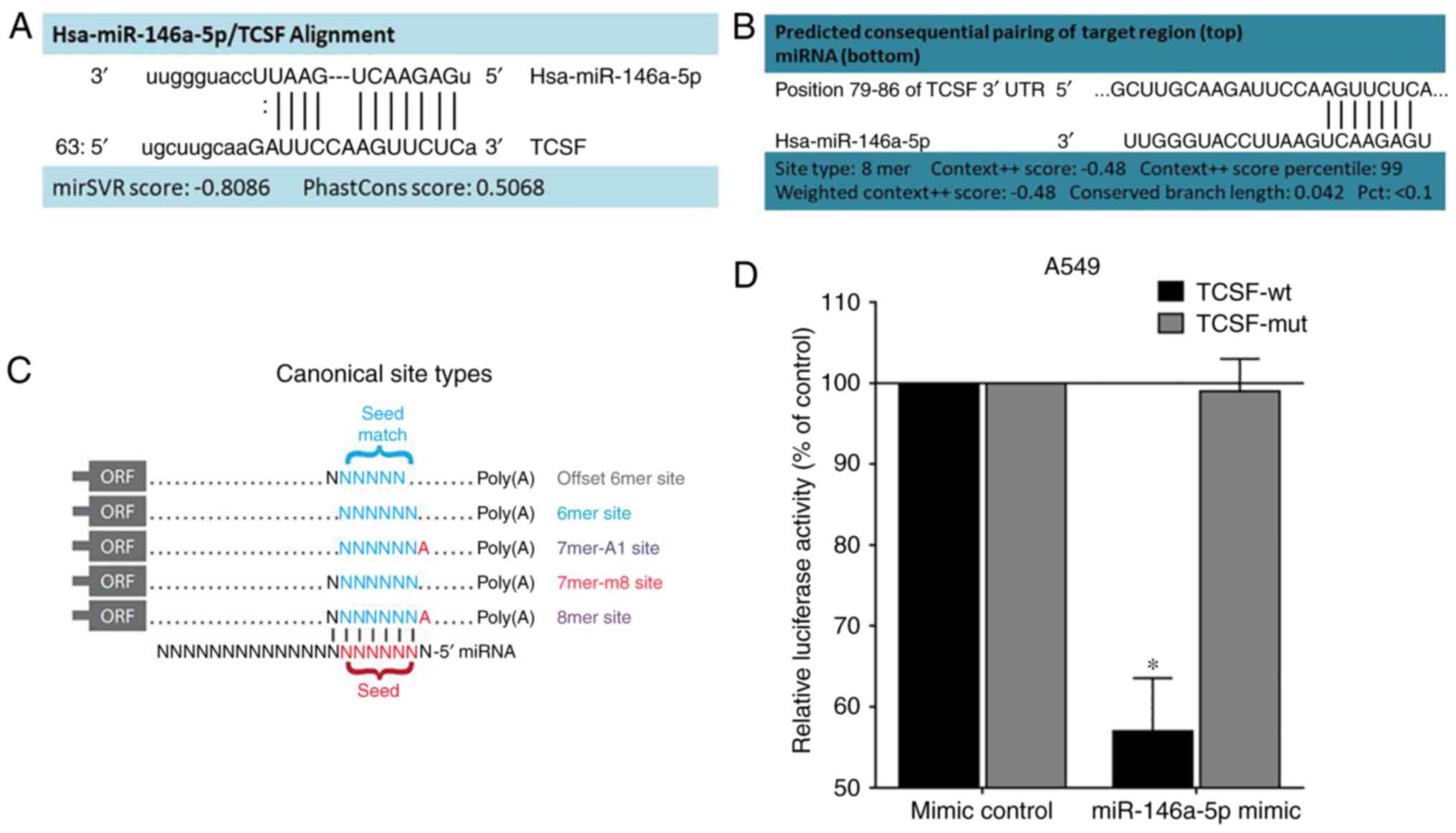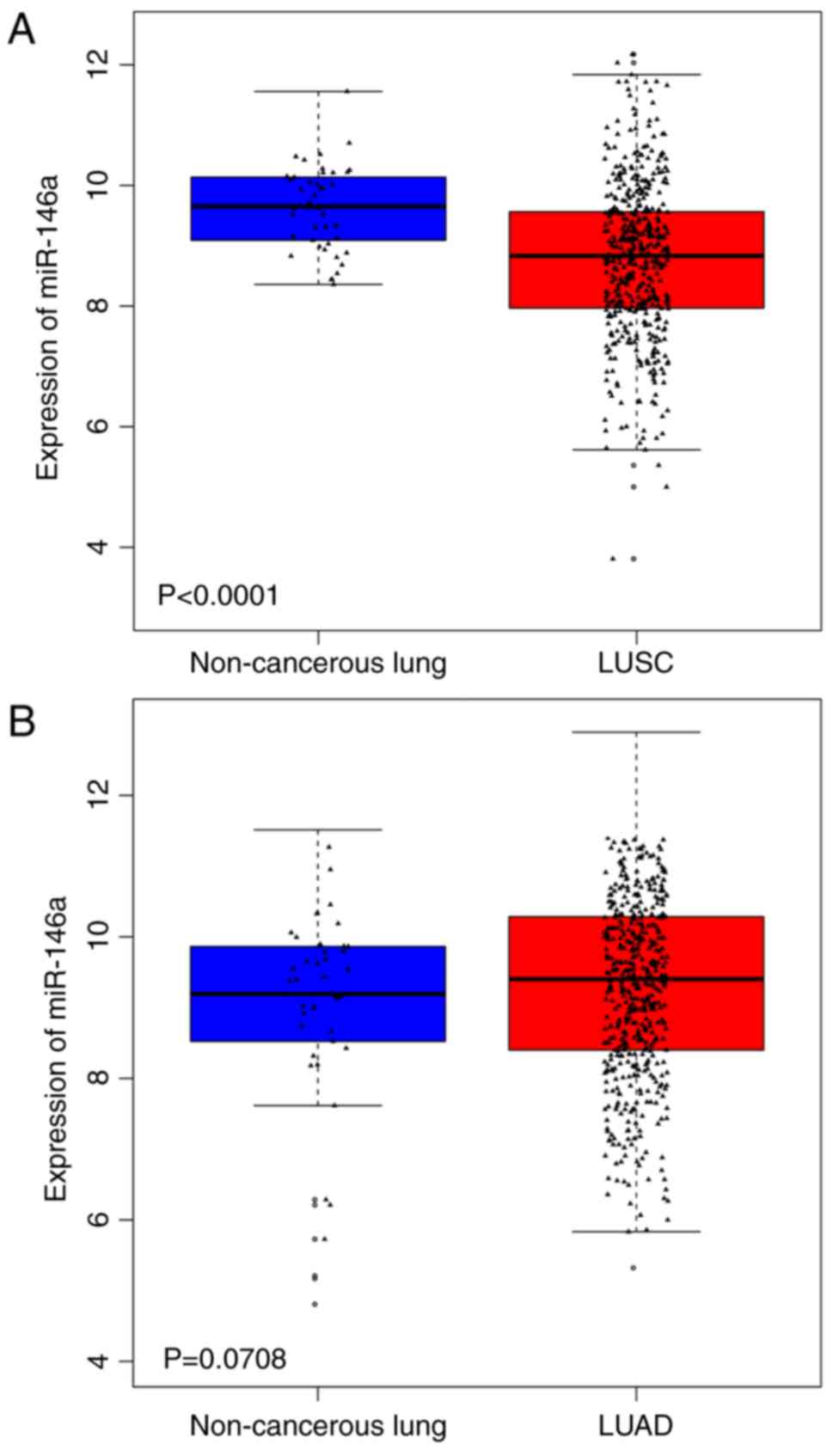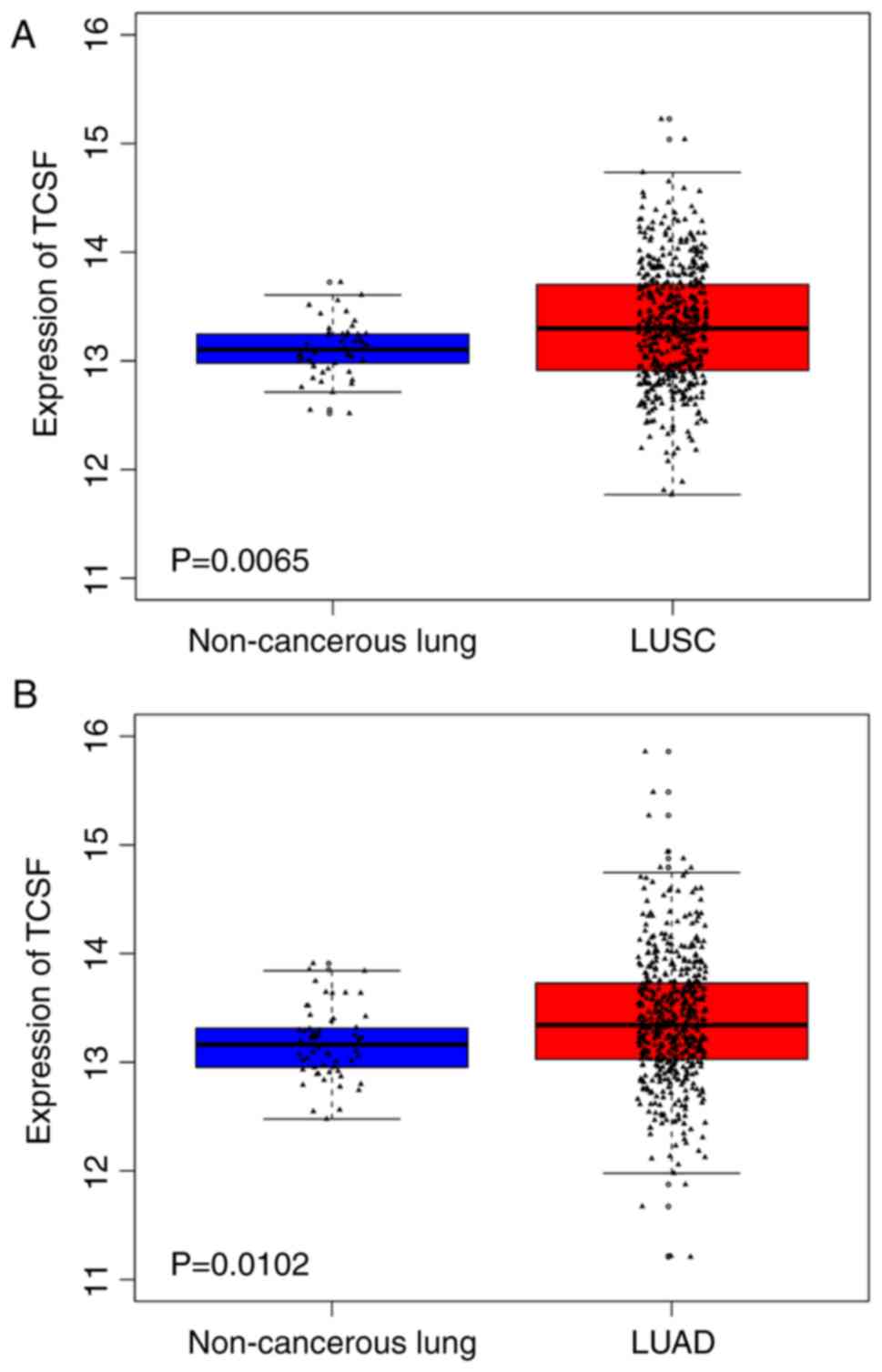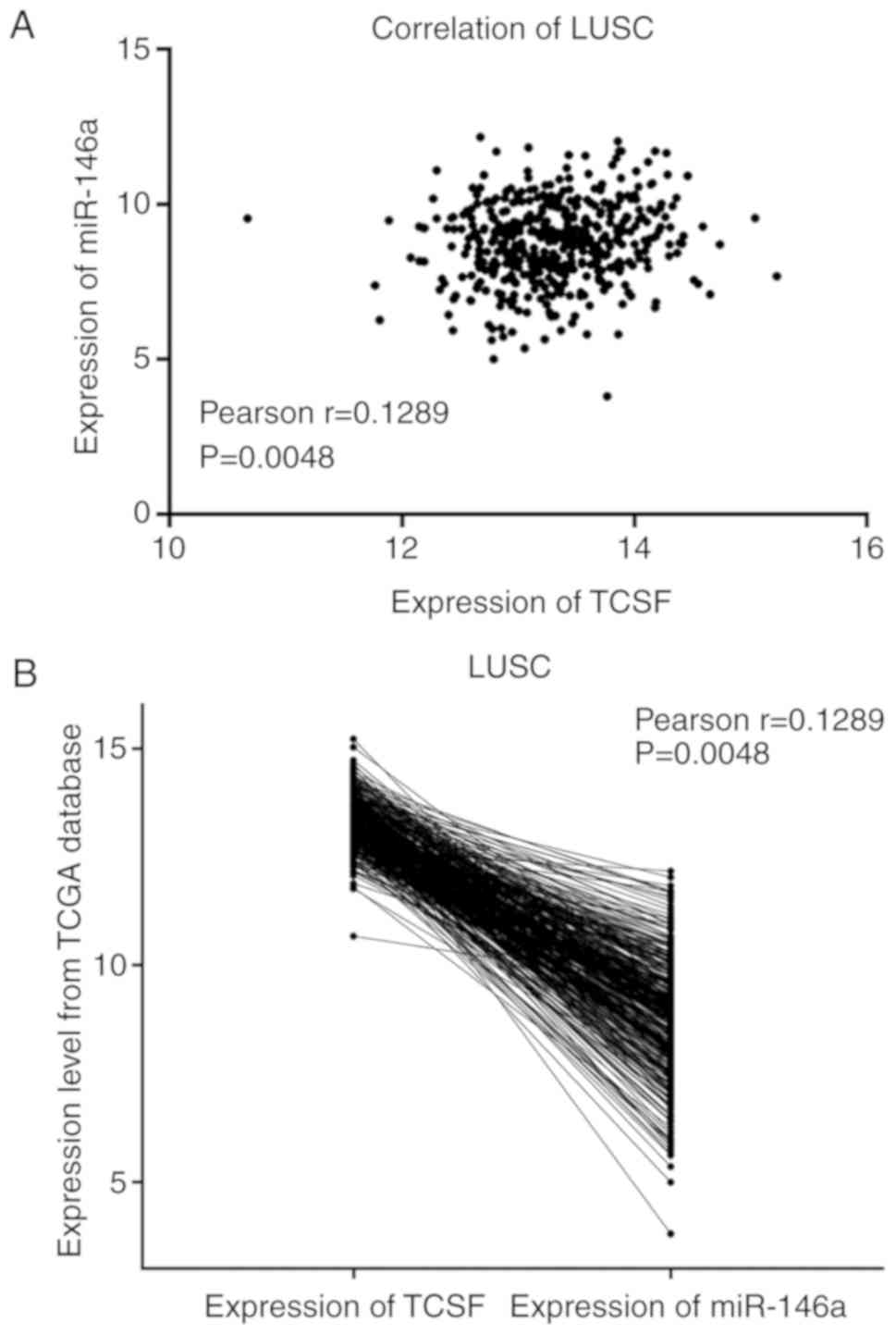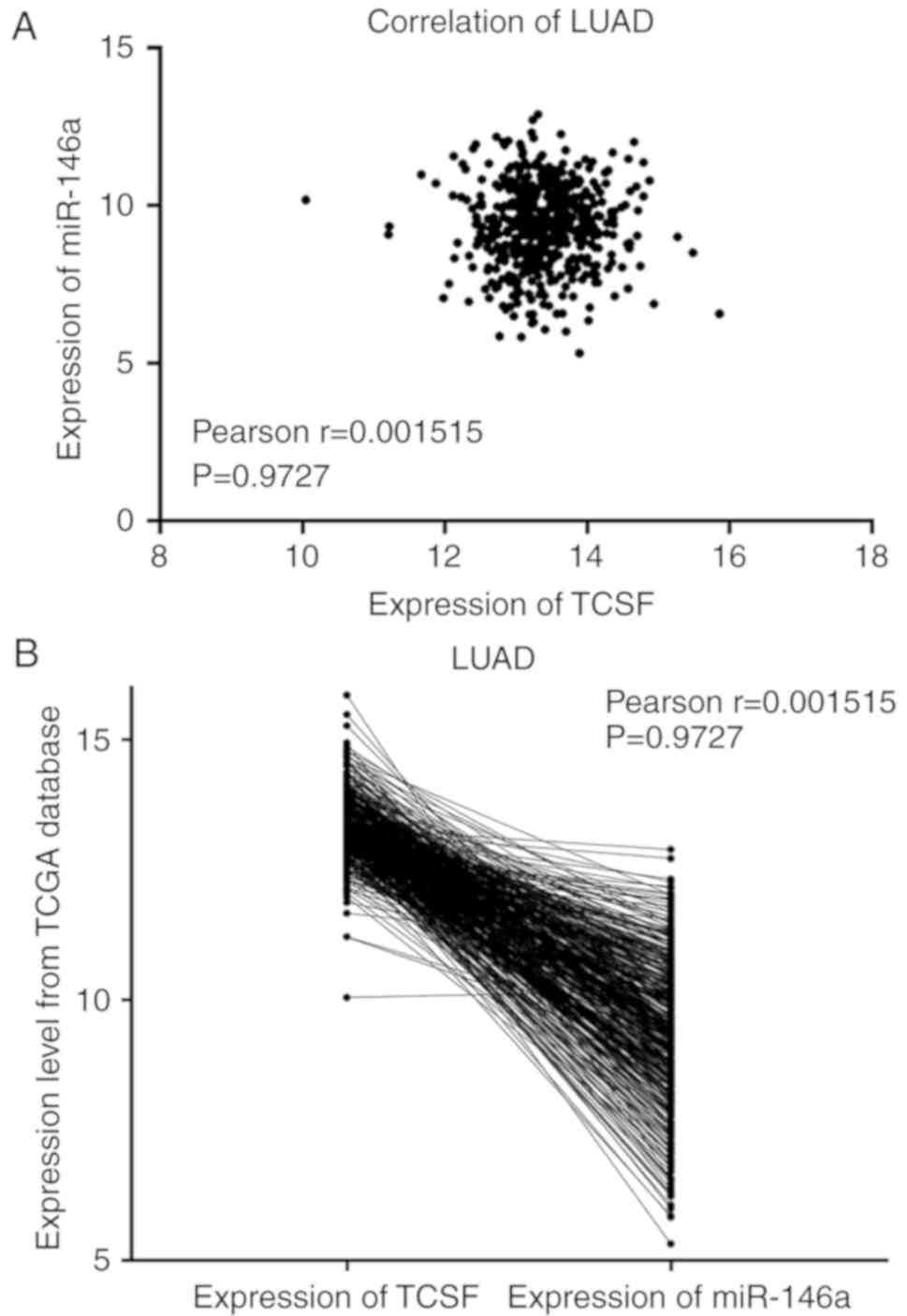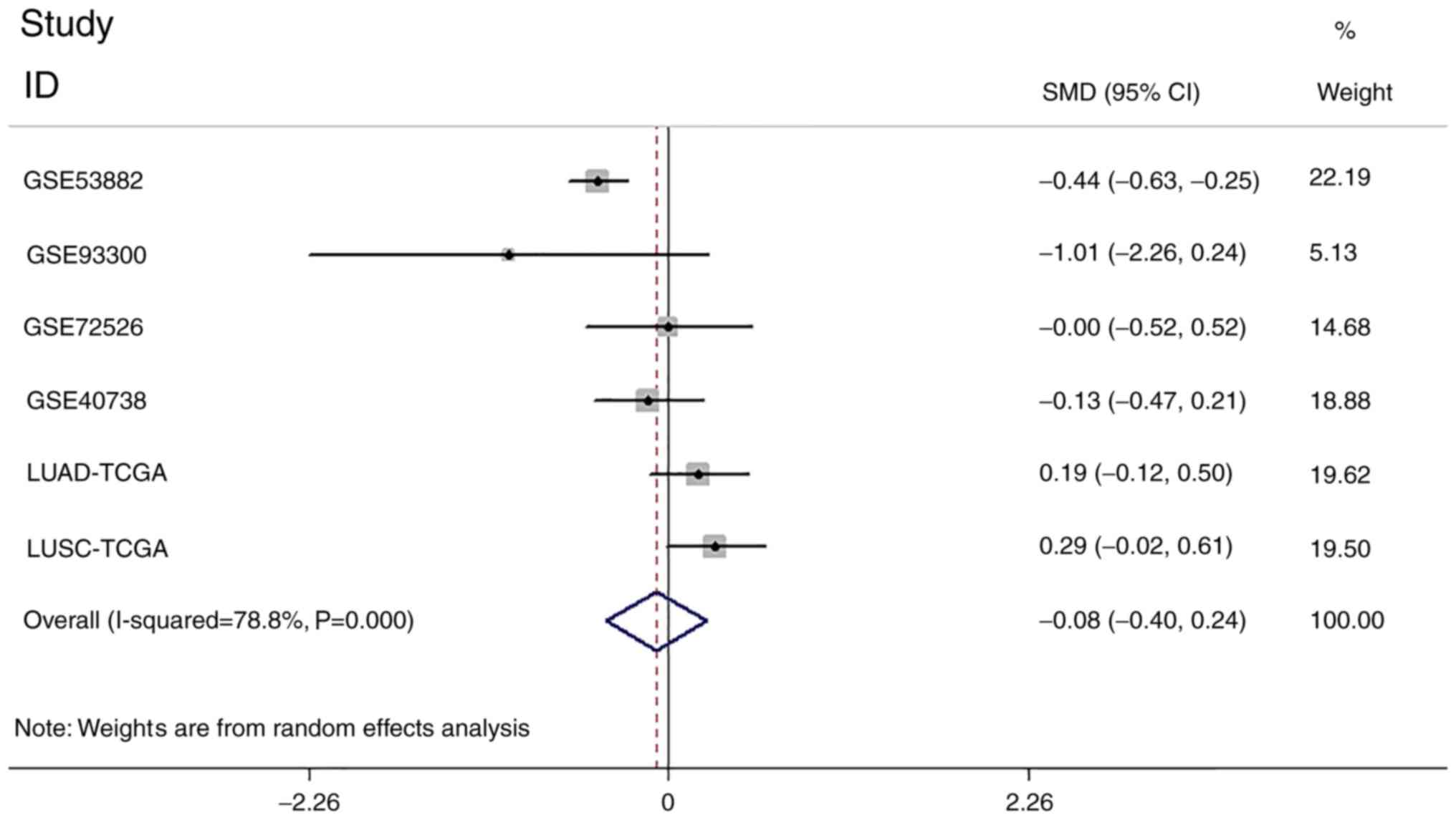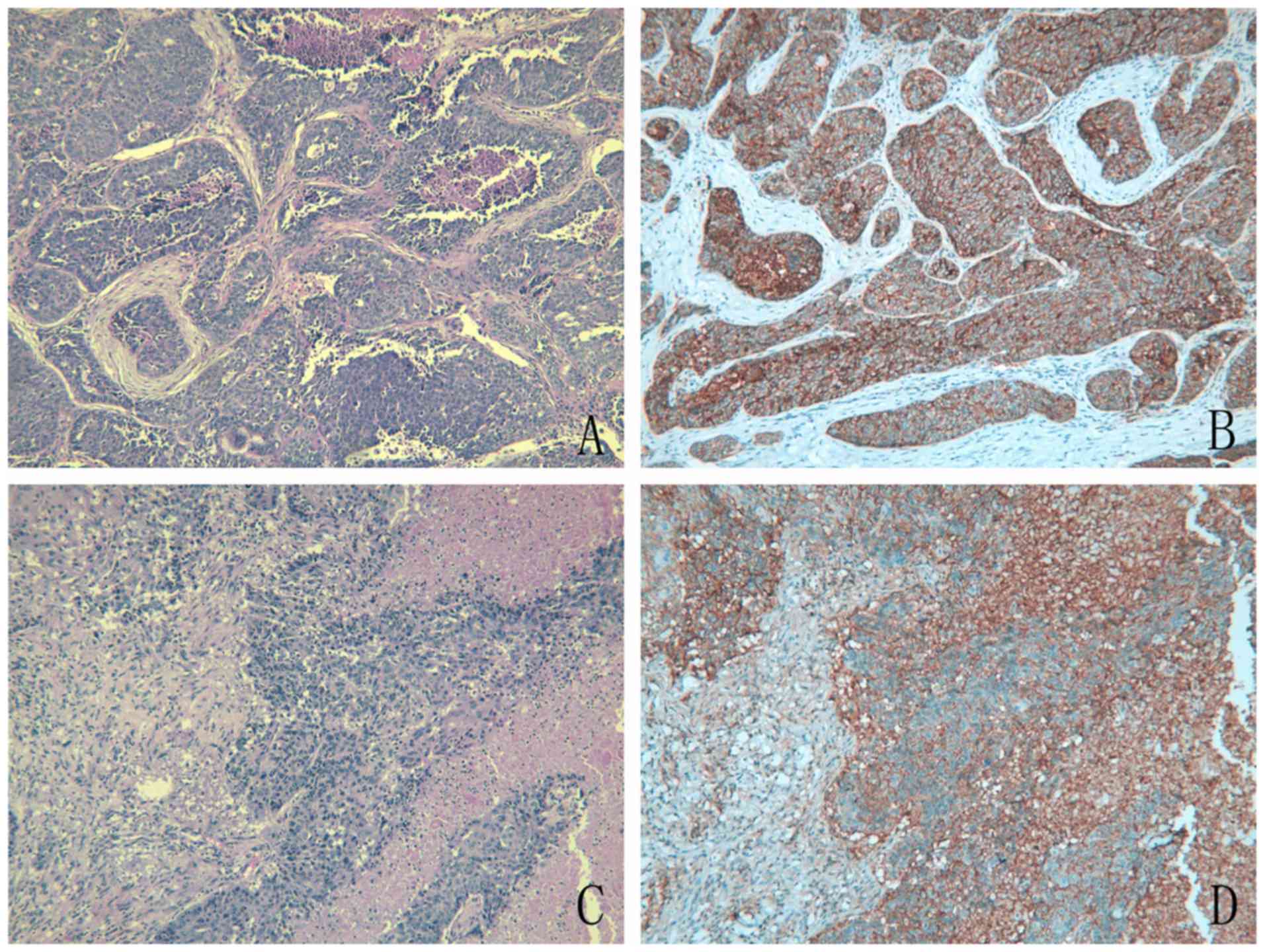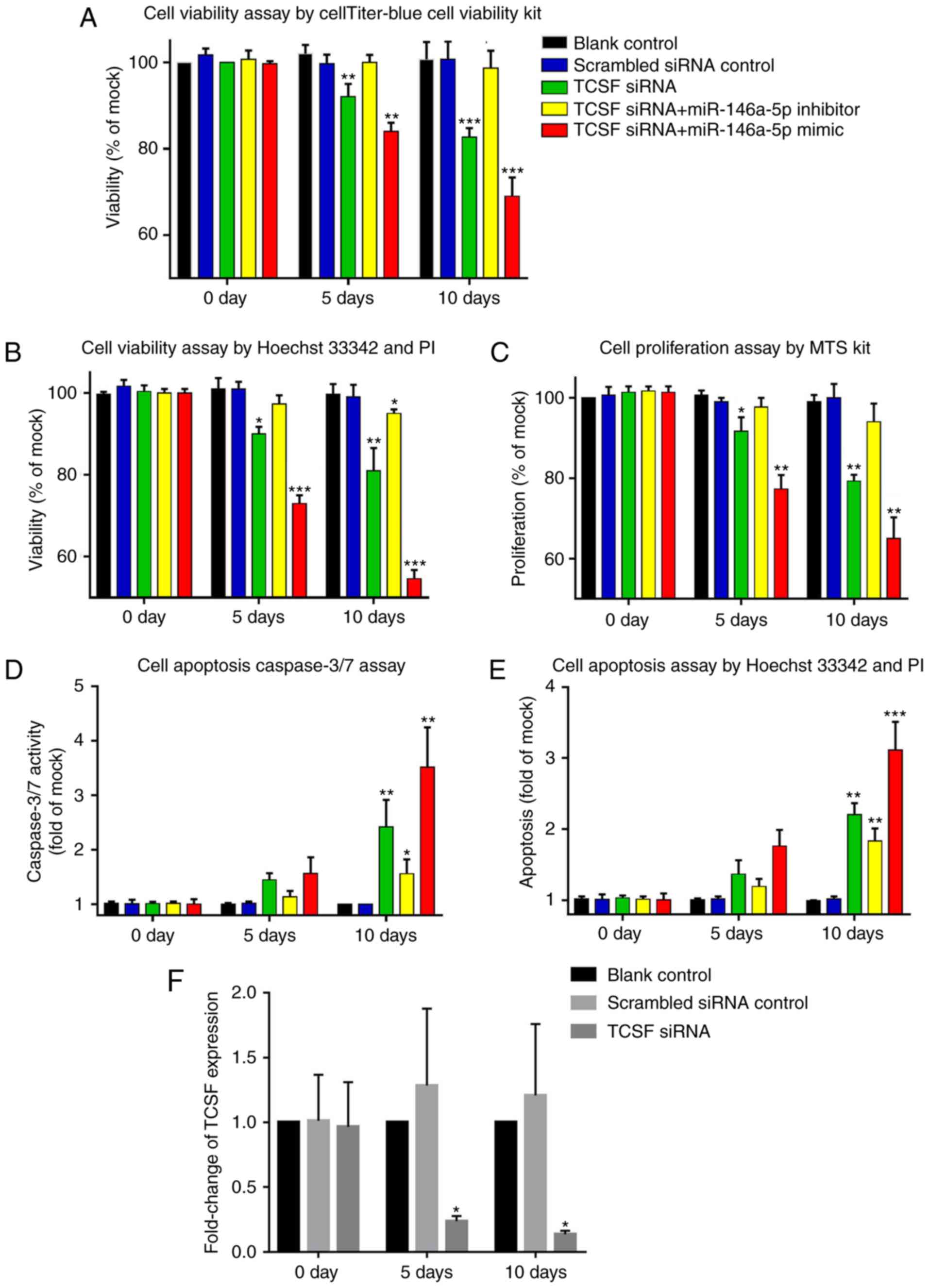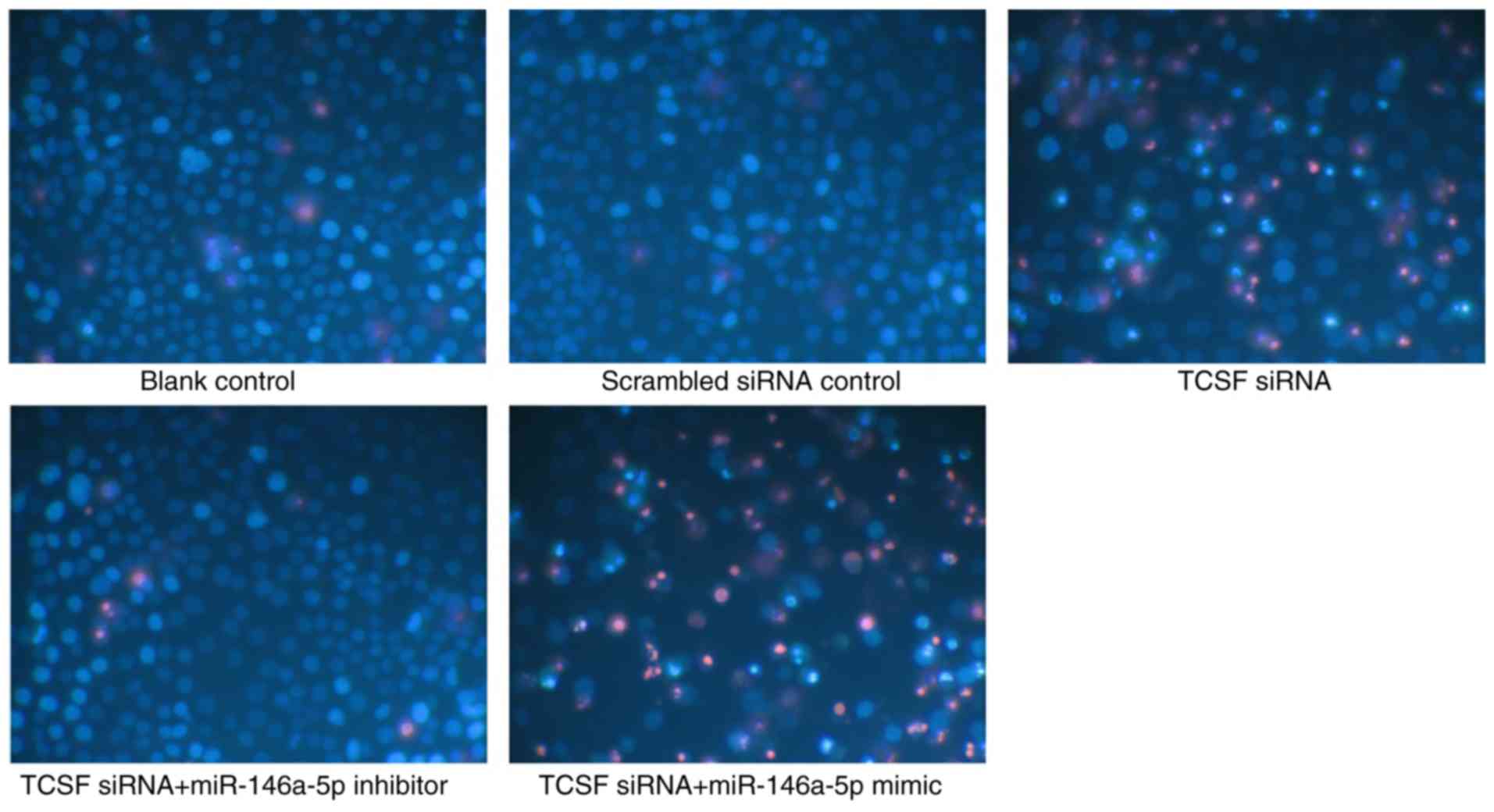|
1
|
Siegel R, Miller K and Jemal A: Cancer
statistics, 2018. CA Cancer J Clin. 68:7–30. 2018. View Article : Google Scholar : PubMed/NCBI
|
|
2
|
Tian X, Zhang L, Jiao Y, Chen J, Shan Y
and Yang W: CircABCB10 promotes nonsmall cell lung cancer cell
proliferation and migration by regulating the miR-1252/FOXR2 axis.
J Cell Biochem. 120:3765–3772. 2019. View Article : Google Scholar : PubMed/NCBI
|
|
3
|
Chiba M, Togashi Y, Tomida S, Mizuuchi H,
Nakamura Y, Banno E, Hayashi H, Terashima M, De Velasco MA, Sakai
K, et al: MEK inhibitors against MET-amplified non-small
cell lung cancer. Int J Oncol. 49:2236–2244. 2016. View Article : Google Scholar : PubMed/NCBI
|
|
4
|
He C, Liu Y, Xu Z, Dai P, Chen X and Jin
D: Astragaloside IV enhances cisplatin chemosensitivity in
non-small cell lung cancer cells through inhibition of B7-H3. Cell
Physiol Biochem. 40:1221–1229. 2016. View Article : Google Scholar : PubMed/NCBI
|
|
5
|
Ma N, Zhang W, Qiao C, Luo H, Zhang X, Liu
D, Zang S, Zhang L and Bai J: The tumor suppressive role of
MiRNA-509-5p by targeting FOXM1 in non-small cell lung cancer. Cell
Physiol Biochem. 38:1435–1446. 2016. View Article : Google Scholar : PubMed/NCBI
|
|
6
|
Wang L, Chen Z, An L, Wang Y, Zhang Z, Guo
Y and Liu C: Analysis of long non-coding RNA expression profiles in
non-small cell lung cancer. Cell Physiol Biochem. 38:2389–2400.
2016. View Article : Google Scholar : PubMed/NCBI
|
|
7
|
Zhang L, Huang Y, Zhuo W, Zhu Y, Zhu B and
Chen Z: Fisetin, a dietary phytochemical, overcomes
Erlotinib-resistance of lung adenocarcinoma cells through
inhibition of MAPK and AKT pathways. Am J Transl Res. 8:4857–4868.
2016.PubMed/NCBI
|
|
8
|
Schneider BJ, Kalemkerian GP, Gadgeel SM,
Valdivieso M, Hackstock DM, Chen W, Heilbrun LK, Ruckdeschel JC and
Wozniak AJ: Phase II trial of dose-dense pemetrexed, gemcitabine,
and bevacizumab in patients with advanced, non-small-cell lung
cancer. Clin Lung Cancer. 18:299–302. 2017. View Article : Google Scholar : PubMed/NCBI
|
|
9
|
He Y, Zhang X, Wang L, Tian Z, Liu Q, Yao
J, Liu Y, Li C, Min L and Shan B: Detection of cancer specific
mutations in early-stage non-small cell lung cancer using cell-free
DNA by targeted sequencing. Int J Oncol. 49:2351–2358. 2016.
View Article : Google Scholar : PubMed/NCBI
|
|
10
|
Liu M, Zhou C and Zheng J: Cigarette
smoking impairs the response of EGFR-TKIs therapy in lung
adenocarcinoma patients by promoting EGFR signaling and
epithelial-mesenchymal transition. Am J Transl Res. 7:2026–2035.
2015.PubMed/NCBI
|
|
11
|
Wu J, Li S, Ma R, Sharma A, Bai S, Dun B,
Cao H, Jing C, She J and Feng J: Tumor profiling of co-regulated
receptor tyrosine kinase and chemoresistant genes reveal different
targeting options for lung and gastroesophageal cancers. Am J
Transl Res. 8:5729–5740. 2016.PubMed/NCBI
|
|
12
|
Zhang N, Zeng Y, Du W, Zhu J, Shen D, Liu
Z and Huang JA: The EGFR pathway is involved in the regulation of
PD-L1 expression via the IL-6/JAK/STAT3 signaling pathway in
EGFR-mutated non-small cell lung cancer. Int J Oncol. 49:1360–1368.
2016. View Article : Google Scholar : PubMed/NCBI
|
|
13
|
Shi Y, Li J, Zhang S, Wang M, Yang S, Li
N, Wu G, Liu W, Liao G, Cai K, et al: Molecular epidemiology of
EGFR mutations in asian patients with advanced non-small-cell lung
cancer of adenocarcinoma histology-mainland china subset analysis
of the PIONEER study. PLoS One. 10:e01435152015. View Article : Google Scholar : PubMed/NCBI
|
|
14
|
Hong S, Fang W, Hu Z, Zhou T, Yan Y, Qin
T, Tang Y, Ma Y, Zhao Y, Xue C, et al: A large-scale
cross-sectional study of ALK rearrangements and EGFR mutations in
non-small-cell lung cancer in Chinese Han population. Sci Rep.
4:72682014. View Article : Google Scholar : PubMed/NCBI
|
|
15
|
Shyamasundar S, Lim J and Bay B: miR-93
inhibits the invasive potential of triple-negative breast cancer
cells in vitro via protein kinase WNK1. Int J Oncol.
49:2629–2636. 2016. View Article : Google Scholar : PubMed/NCBI
|
|
16
|
Turconi G, Scaldaferri D, Fabbri M, Monti
L, Lualdi M, Pedrini E, Gribaldo L, Taramelli R and Acquati F:
RNASET2 silencing affects miRNAs and target gene expression
pattern in a human ovarian cancer cell model. Int J Oncol.
49:2637–2646. 2016. View Article : Google Scholar : PubMed/NCBI
|
|
17
|
Yin Y, Li F, Shi J, Li S, Cai J and Jiang
Y: MiR-146a regulates inflammatory infiltration by macrophages in
polymyositis/dermatomyositis by targeting TRAF6 and affecting
IL-17/ICAM-1 pathway. Cell Physiol Biochem. 40:486–498. 2016.
View Article : Google Scholar : PubMed/NCBI
|
|
18
|
Zhang L, Huang L, Chen G and Feng Z:
Potential targets and clinical value of MiR-224-5p in cancers of
the digestive tract. Cell Physiol Biochem. 44:682–700. 2017.
View Article : Google Scholar : PubMed/NCBI
|
|
19
|
Zhi Y, Pan J, Shen W, He P, Zheng J, Zhou
X, Lu G, Chen Z and Zhou Z: Ginkgolide B inhibits human bladder
cancer cell migration and invasion through MicroRNA-223-3p. Cell
Physiol Biochem. 39:1787–1794. 2016. View Article : Google Scholar : PubMed/NCBI
|
|
20
|
Chen G, Umelo I, Lv S, Teugels E, Fostier
K, Kronenberger P, Dewaele A, Sadones J, Geers C and De Grève J:
miR-146a inhibits cell growth, cell migration and induces apoptosis
in non-small cell lung cancer cells. PLoS One. 8:e603172013.
View Article : Google Scholar : PubMed/NCBI
|
|
21
|
Hausser J and Zavolan M: Identification
and consequences of miRNA-target interactions-beyond repression of
gene expression. Nat Rev Genet. 15:599–612. 2014. View Article : Google Scholar : PubMed/NCBI
|
|
22
|
Nakanishi K: Anatomy of RISC: How do small
RNAs and chape-rones activate Argonaute proteins? Wiley Interdiscip
Rev RNA. 7:637–660. 2016. View Article : Google Scholar : PubMed/NCBI
|
|
23
|
Friedman R, Farh K, Burge C and Bartel D:
Most mammalian mRNAs are conserved targets of microRNAs. Genome
Res. 19:92–105. 2009. View Article : Google Scholar : PubMed/NCBI
|
|
24
|
Kozomara A and Griffiths-Jones S: miRBase:
Annotating high confidence microRNAs using deep sequencing data.
Nucleic Acids Res. 42:D68–D73. 2014. View Article : Google Scholar : PubMed/NCBI
|
|
25
|
Muramatsu T: Basigin (CD147), a
multifunctional transmembrane glycoprotein with various binding
partners. J Biochem. 159:481–490. 2016. View Article : Google Scholar : PubMed/NCBI
|
|
26
|
Li X, Yu X, Dai D, Song X and Xu W: The
altered glucose metabolism in tumor and a tumor acidic
microenvironment associated with extracellular matrix
metalloproteinase inducer and monocarboxylate transporters.
Oncotarget. 7:23141–23155. 2016.PubMed/NCBI
|
|
27
|
Gao C, Lu C and Chen J: Biological
characteristics of cluster of differentiation 147 and its
relationship with tumour. Zhongguo Yi Xue Ke Xue Yuan Xue Bao.
38:589–593. 2016.PubMed/NCBI
|
|
28
|
Hu X, Su J, Zhou Y, Xie X, Peng C, Yuan Z
and Chen X: Repressing CD147 is a novel therapeutic strategy for
malignant melanoma. Oncotarget. 8:25806–25813. 2017.PubMed/NCBI
|
|
29
|
Betel D, Koppal A, Agius P, Sander C and
Leslie C: Comprehensive modeling of microRNA targets predicts
functional non-conserved and non-canonical sites. Genome Biol.
11:R902010. View Article : Google Scholar : PubMed/NCBI
|
|
30
|
Wang X: Improving microRNA target
prediction by modeling with unambiguously identified
microRNA-target pairs from CLIP-ligation studies. Bioinformatics.
32:1316–1322. 2016. View Article : Google Scholar : PubMed/NCBI
|
|
31
|
Wong N and Wang X: miRDB: An online
resource for microRNA target prediction and functional annotations.
Nucleic Acids Res. 43:D146–D152. 2015. View Article : Google Scholar : PubMed/NCBI
|
|
32
|
Agarwal V, Bell G, Nam J and Bartel D:
Predicting effective microRNA target sites in mammalian mRNAs.
Elife. 4:2015. View Article : Google Scholar
|
|
33
|
Fromm B, Billipp T, Peck L, Johansen M,
Tarver JE, King BL, Newcomb JM, Sempere LF, Flatmark K, Hovig E, et
al: A uniform system for the annotation of vertebrate microRNA
genes and the evolution of the human microRNAome. Annu Rev Genet.
49:213–242. 2015. View Article : Google Scholar : PubMed/NCBI
|
|
34
|
Gao X, Wu Y, Yu W and Li H: Identification
of a seven-miRNA signature as prognostic biomarker for lung
squamous cell carcinoma. Oncotarget. 7:81670–81679. 2016.
View Article : Google Scholar : PubMed/NCBI
|
|
35
|
Xia W, Chen Q, Wang J, Mao Q, Dong G, Shi
R, Zheng Y, Xu L and Jiang F: DNA methylation mediated silencing of
microRNA-145 is a potential prognostic marker in patients with lung
adenocarcinoma. Sci Rep. 5:169012015. View Article : Google Scholar : PubMed/NCBI
|
|
36
|
Xie K, Ma H, Liang C, Wang C, Qin N, Shen
W, Gu Y, Yan C, Zhang K, Dai N, et al: A functional variant in
miR-155 regulation region contributes to lung cancer risk and
survival. Oncotarget. 6:42781–42792. 2015. View Article : Google Scholar : PubMed/NCBI
|
|
37
|
Xie K, Wang C, Qin N, Yang J, Zhu M, Dai
J, Jin G, Shen H, Ma H and Hu Z: Genetic variants in regulatory
regions of microRNAs are associated with lung cancer risk.
Oncotarget. 7:47966–47974. 2016.PubMed/NCBI
|
|
38
|
Gao L, Zhong J, Huang W, Dang Y, Kang M
and Chen G: Integrative analysis of BSG expression in NPC through
immunohistochemistry and public high-throughput gene expression
data. Am J Transl Res. 9:4574–4592. 2017.PubMed/NCBI
|
|
39
|
Huang W, Gao L, He R, Ma J, Wei K and Chen
G: Over-expressed CD147 may be a reminder of tumor progression in
cervical lesions: An immunohistochemical investigation with 494
cases. Int J Clin Exp Pathol. 10:3189–3198. 2017.
|
|
40
|
Livak KJ and Schmittgen TD: Analysis of
relative gene expression data using real-time quantitative PCR and
the 2−ΔΔCT method. Methods. 25:402–408. 2001. View Article : Google Scholar : PubMed/NCBI
|
|
41
|
He R, Yang L, Lin X, Chen X, Lin X, Wei F,
Liang X, Luo Y, Wu Y, Gan T, et al: MiR-30a-5p suppresses cell
growth and enhances apoptosis of hepatocellular carcinoma cells via
targeting AEG-1. Int J Clin Exp Pathol. 8:15632–15641.
2015.PubMed/NCBI
|
|
42
|
Li JJ, Luo J, Lu JN, Liang XN, Luo YH, Liu
YR, Yang J, Ding H, Qin GH, Yang LH, et al: Relationship between
TRAF6 and deterioration of HCC: An immunohistochemical and in vitro
study. Cancer Cell Int. 16:762016. View Article : Google Scholar : PubMed/NCBI
|
|
43
|
Tang R, Zhong T, Dang Y, Zhang X, Li P and
Chen G: Association between downexpression of MiR-203 and poor
prognosis in non-small cell lung cancer patients. Clin Transl
Oncol. 18:360–368. 2016. View Article : Google Scholar : PubMed/NCBI
|
|
44
|
Zhang Y, Huang S, Leng Y, Chen X, Liu T,
Wang H, Wei F, Luo D, Chen G and Wei Z: Effect of DcR3-specific
siRNA on cell growth suppression and apoptosis induction in glioma
cells via affecting ERK and AKT. Onco Targets Ther. 9:5195–5202.
2016. View Article : Google Scholar : PubMed/NCBI
|
|
45
|
Huang W, Wang H, Yang H, Ren FH, Luo YH,
Huang CQ, Liang YY, Liang HW, Chen G and Dang YW: Lower expressed
miR-198 and its potential targets in hepatocellular carcinoma: A
clinicopathological and in silico study. Onco Targets Ther.
9:5163–5180. 2016. View Article : Google Scholar : PubMed/NCBI
|
|
46
|
Li CY, Pang YY, Yang H, Li J, Lu HX, Wang
HL, Mo WJ, Huang LS, Feng ZB and Chen G: Identification of
miR-101-3p targets and functional features based on bioinformatics,
meta-analysis and experimental verification in hepatocellular
carcinoma. Am J Transl Res. 9:2088–2105. 2017.PubMed/NCBI
|
|
47
|
Zhang Y, Chen WJ, Gan TQ, Zhang XL, Xie
ZC, Ye ZH, Deng Y, Wang ZF, Cai KT, Li SK, et al: Clinical
significance and effect of lncRNA HOXA11-AS in NSCLC: A study based
on bioinformatics, in vitro and in vivo verification. Sci Rep.
7:55672017. View Article : Google Scholar : PubMed/NCBI
|
|
48
|
Zhong DN, Luo YH, Mo WJ, Zhang X, Tan Z,
Zhao N, Pang SM, Chen G, Rong MH and Tang W: High expression of
long non-coding HOTAIR correlated with hepatocarcinogenesis and
metastasis. Mol Med Rep. 17:1148–1156. 2018.PubMed/NCBI
|
|
49
|
He R, Gao L, Ma J, Peng Z, Zhou S, Yang L,
Feng Z, Dang Y and Chen G: The essential role of MTDH in the
progression of HCC: A study with immunohistochemistry, TCGA,
meta-analysis and in vitro investigation. Am J Transl Res.
9:1561–1579. 2017.PubMed/NCBI
|
|
50
|
Achkar NP, Cambiagno DA and Manavella PA:
miRNA bioge-nesis: A dynamic pathway. Trends Plant Sci.
21:1034–1044. 2016. View Article : Google Scholar : PubMed/NCBI
|
|
51
|
Beermann J, Piccoli MT, Viereck J and Thum
T: Non-coding RNAs in development and disease: Background,
mechanisms, and therapeutic approaches. Physiol Rev. 96:1297–325.
2016. View Article : Google Scholar : PubMed/NCBI
|
|
52
|
Miranda KC, Huynh T, Tay Y, Ang YS, Tam
WL, Thomson AM, Lim B and Rigoutsos I: A pattern-based method for
the identification of MicroRNA binding sites and their
corresponding heteroduplexes. Cell. 126:1203–1217. 2006. View Article : Google Scholar : PubMed/NCBI
|
|
53
|
Zhang X, Dang Y, Li P, Rong M and Chen G:
Expression of IRAK1 in lung cancer tissues and its
clinicopathological significance: A microarray study. Int J Clin
Exp Pathol. 7:8096–8104. 2014.PubMed/NCBI
|
|
54
|
Zhang XL, Dang YW, Li P, Rong MH, Hou XX,
Luo DZ and Chen G: Expression of tumor necrosis factor
receptor-associated factor 6 in lung cancer tissues. Asian Pac J
Cancer Prev. 15:10591–10596. 2014. View Article : Google Scholar : PubMed/NCBI
|
|
55
|
Chou CH, Chang NW, Shrestha S, Hsu SD, Lin
YL, Lee WH, Yang CD, Hong HC, Wei TY, Tu SJ, et al: miRTarBase
2016: Updates to the experimentally validated miRNA-target
interactions database. Nucleic Acids Res. 44:D239–D247. 2016.
View Article : Google Scholar : PubMed/NCBI
|
|
56
|
Xu B, Huang Y, Niu X, Tao T, Jiang L, Tong
N, Chen S, Liu N, Zhu W and Chen M: Hsa-miR-146a-5p modulates
androgen-independent prostate cancer cells apoptosis by targeting
ROCK1. Prostate. 75:1896–1903. 2015. View Article : Google Scholar : PubMed/NCBI
|
|
57
|
Yang RQ, Teng H, Xu XH, Liu SY, Wang YH,
Guo FJ and Liu XJ: Microarray analysis of microRNA deregulation and
angiogenesis-related proteins in endometriosis. Genet Mol Res.
15:2016.
|
|
58
|
Yap E, Norziha Z, Simbun A, Tumian NR,
Cheong SK, Leong CF and Wong CL: MicroRNAs that affect the Fanconi
Anemia/BRCA pathway are downregulated in imatinib-resistant chronic
myeloid leukemia patients without detectable BCR-ABL kinase
domain mutations. Leuk Res. 59:32–40. 2017. View Article : Google Scholar : PubMed/NCBI
|
|
59
|
Zhang Z, Zhang Y, Sun X, Ma X and Chen Z:
microRNA-146a inhibits cancer metastasis by downregulating VEGF
through dual pathways in hepatocellular carcinoma. Mol Cancer.
14:52015. View Article : Google Scholar : PubMed/NCBI
|















